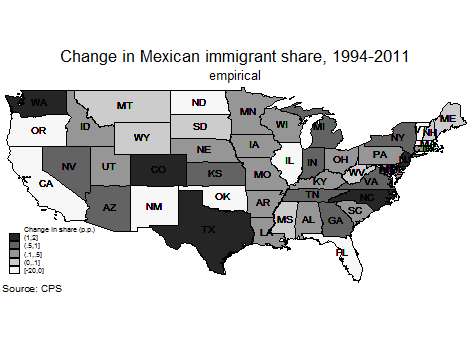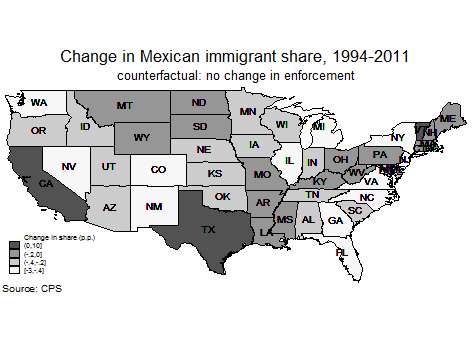As US border enforcement increases, Mexican migration patterns shift, new research shows

When enforcement increases along the U.S.-Mexican border, fewer Mexican immigrants cross into the United States, both legally and illegally. But increased enforcement has another effect, new research shows - it alters traditional settlement patterns and leads more Mexican immigrants to settle in states beyond the borders.
"Mexicans recently have been settling in parts of the U.S. where historically they have not lived in large numbers," said Todd Pugatch, an assistant professor of economics in the College of Liberal Arts at Oregon State University. "The concentration of Mexican immigrants in traditional settlement areas such as California and Texas has declined substantially in the last 30 years."
Research by Pugatch and Sarah Bohn of the Public Policy Institute of California showed that for every 1,000 additional border patrol agents assigned to prevent unauthorized migration to a U.S. state, the state's share of Mexican immigrants declined by nearly 22 percentage points during the period from 1994 to 2011. The findings were published today in the journal Demography.
"We're not looking at whether the total number of immigrants goes up or down," Pugatch said. "What our paper is showing is how, at a given time, immigrants are dispersed. It's like squeezing a balloon. The total amount of air is the same, but the shape is changed."
Pugatch studies the effect of Mexican immigration on labor markets in the U.S., as well as the economic effects of migration by people from developing countries. This research is part of a broader effort to understand more about the decisions involved in migrating to and settling in a new country, he said. The researchers focused on Mexico because the largest share of U.S. immigrants is from there.
"The decision to migrate to another country is one of the biggest decisions a person can make," Pugatch said. "They are leaving behind their family and friends in search of a new life. Often the decisions have to do with economic opportunities, but that is not the whole story."

To better understand how border policy affects migration, Pugatch and Bohn compared data on Mexican immigrants' residential locations in the U.S. to Border Patrol staffing information. They used data on historical border crossing patterns to connect border enforcement to each U.S. state.
Their research showed that increased enforcement in a state resulted in a lower share of Mexican immigrants two years later. Because border enforcement budgets are set two years in advance, this finding helps address concerns about whether the enforcement caused the decline in immigration, or a surge in immigration sparked increased enforcement, Pugatch said.
Surges of border patrol agents responding to unanticipated increases in immigration could not be set two years in advance, which strengthens the argument that border enforcement has driven the long-term changes in Mexican immigration patterns, he said.
Pugatch and Bohn found that the concentration of Mexican immigrants to traditional destinations such as California and Texas was virtually unchanged between 1980 and 1990, with 90 percent of immigrants settling in five states. However, between 1990 and 2000, that number dropped, with the top five states pulling in only 76 percent of immigrants. From 2000-2010, the number fell again, to 71 percent.
"Our estimates imply that if border enforcement had not changed from 1994 to 2011, the shares of Mexican immigrants locating in California and Texas would each be eight percentage points greater, with all other states' shares lower or unchanged," Pugatch said.
The study also indicates that immigrants cross in different locations along the border in response to border enforcement changes. That, in turn, leads them to different destinations within the U.S., Pugatch said.
While the traditional destinations lost shares, states such as Illinois, New York, Florida and Georgia drew larger shares of immigrants to their communities. The findings indicate that border enforcement policies have an effect on whether people enter the U.S. as well as on where they end up settling in the U.S., he said.
The researchers don't address the larger questions about whether immigration is positive or negative, or whether current policy is effective. Rather, they believe that understanding how border enforcement efforts affect the decisions of immigrants provides valuable information to law- and policymakers grappling with immigration policy work.
For example, if immigrants from the same area prefer to live in close geographic proximity to one another, border enforcement could also affect where immigrants entering the country legally choose to reside, Pugatch said.
"Policymakers at every level have concerns about how immigrants change social and economic conditions in a community," Pugatch said. "If we can better understand why people end up the places they do, we can better prepare."
Journal information: Demography
Provided by Oregon State University

















